 |
| Mr. Romeo Ramirez giving strategic planning overview |
NISMED conducted a strategic planning meeting on 17-18 January 2019 to develop a new plan for the next five years (2019-2013). Engr. Romeo Ramirez, an ISO consultant and trainer, facilitated the planning workshop which was attended by 21 staff—three from each of the the different academic workgroups and sections of the Institute.
NISMED Director Aida Yap began the session on the first day by citing the Institute’s mandate and revisiting its vision for 2013-2017. She then shared the draft of NISMED’s vision, mission, and core values for 2019-2023 as framed earlier by a small group of academic staff.
Mr. Ramirez gave a brief talk on concepts related to strategic planning as promoted by the International Standards Organization (ISO). The lecture provided the staff with the necessary understanding about the goals and benefits of planning, functions of management, performance parameters, levels of organizational direction, and framework of planning, among other things.
Redefining NISMED’s vision, mission, and core values
To set NISMED’s strategic direction over the next five years, the draft of vision, mission, and core values was critically examined. Mr. Ramirez emphasized that the vision statement should be succinct and the terms clear to everyone. He advised NISMED to go through a benchmarking process to learn what other similar institutions, particularly in the Southeast Asian region, were doing. Mr. Ramirez stressed the need to develop a research agenda that supported NISMED’s vision, as well as come up with indicators to show that the vision had been achieved. He challenged the staff to set a deadline when the vision was expected to be realized and a new one established.
While the vision might be changed after achieving it, Mr. Ramirez clarified that the mission statement could not be altered to a large extent because the mandate of NISMED remained the same. The mission statement must take into consideration the stakeholders which will benefit from it such as the Department of Education (DepEd) and the Commission on Higher Education (CHED).
Mr. Ramirez also emphasized the importance of holding the staff to a code of conduct which is articulated in the core values of an organization. The core values may be viewed as an extension of a mission statement, and can be referred to as behaviors that the staff should manifest and recognize in the organization.
Revisiting NISMED’s past performance and validating its current operating environment
To aid in the planning, former Director Soledad Ulep gave a summary of the Institute’s previous accomplishments. Considering the list impressive, Mr. Ramirez raised a few questions: What lessons could be learned from the past performance? What organizational challenges were encountered? Which tasks were intentionally planned and actually materialized? The current situation of the Institute was examined via a presentation of NISMED’s strengths, weaknesses, opportunities, and threats (SWOT) as identified by the academic workgroups and sections. This was presented by Dr. Erlina Ronda, Deputy Director for Research and Extension.
Developing appropriate strategies for achieving goals
On the succeeding day, Mr. Ramirez led the planning group in reviewing and validating the results of the SWOT analyses that were later used as bases to formulate the strategies to carry out the mission of the Institute. Owing to lack of time, the group agreed to finalize the strategic plan at a later date. Mr. Ramirez promised to help until everything was completed.
 |
| NISMED staff take a break from the Strategic Planning Workshop with Engr. Romeo Ramirez and Director Aida Yap (front, second and third from right, respectively) |
by D. Danipog





0 Comments